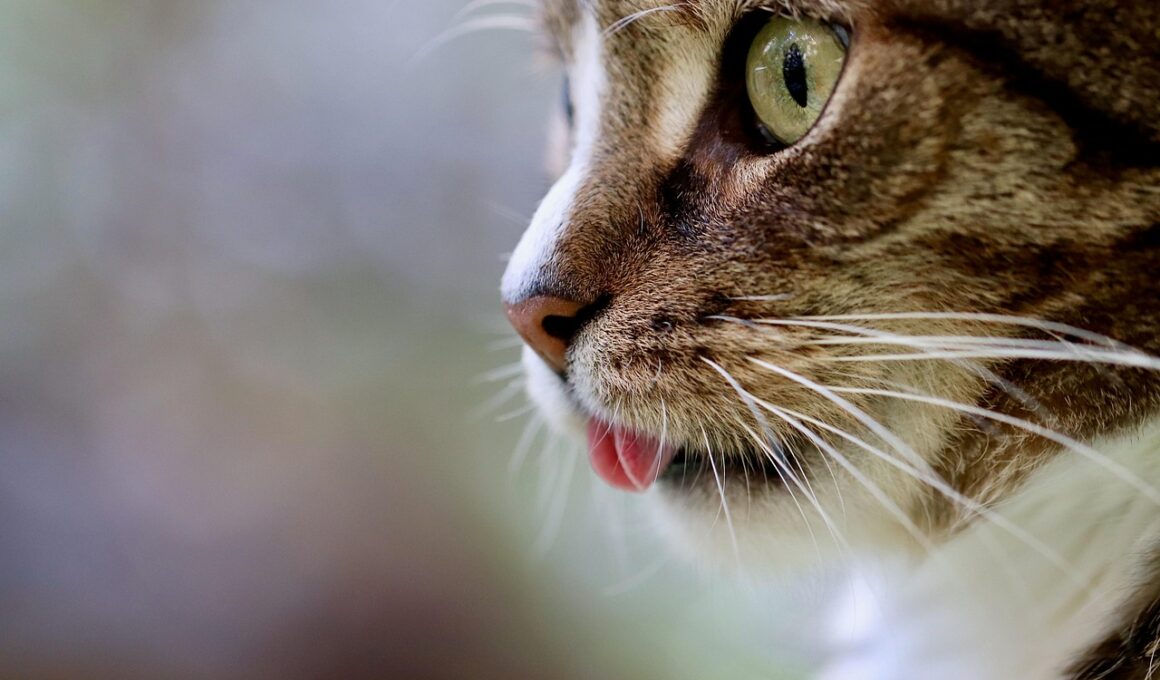Recognizing Stress vs Happiness in Cats
Understanding your cat’s behavior can sometimes be tricky. Unlike dogs, cats express their emotions differently and may not respond the same way to stimuli. Recognizing when your cat feels happy is crucial for building a positive relationship with them. Observing their body language, vocalizations, and actions can provide helpful insights into their emotional state. For example, a relaxed cat will have a more upright tail and supple posture. In contrast, signs of stress can manifest through hiding, excessive grooming, or even aggression. Determining the mood of a cat ensures proper care and breeds a happy environment for both of you. Attention to detail is key; the more observant you are, the better you can recognize these signs. Providing a safe space for your cat, one with many opportunities for play and relaxation, is essential. Be sure to enrich their environment with stimulating toys and cozy resting spots, ensuring they feel secure. Emotional well-being in cats often leads to great companionship. Learn to read their signs of happiness and stress to enrich your shared experiences.
Happy Signs to Look For
When assessing your cat’s emotional well-being, several identifiable signs indicate happiness. One of the most evident signs is when your cat purrs while sitting close to you. This audible signal usually means your cat is content and relaxed. Additionally, non-vocal behaviors are also essential cues. A playful kitty will initiate wrestling with a toy and keep their tail held high in the air. Ensure your cat has the chance to play a variety of activities. A well-adjusted cat enjoys human interaction and may follow you around or rub against your legs. Taking note of the rhythm of their purring can help; variations often indicate differing emotions. Kittens show even more enthusiasm, often indulging in leaps and bounds that exhibit joy. Furthermore, if your cat kneads their paws against a soft surface, it’s a nostalgic behavior that often indicates comfort. Lastly, grooming habits play a role in happiness. Regular grooming helps improve the bond between you and your cat, making them feel cherished. By observing these signs, you can enhance their quality of life significantly.
Your cat’s tail language is also critical in interpreting their happiness versus stress. A high, upright tail generally indicates a happy cat eager to explore or interact. If the tail is quivering, it signifies your cat is particularly excited to see you or another beloved companion. Contrarily, a lowered tail can denote fear or stress. When a cat’s tail is twitching vigorously, they may be on alert or agitated. Tail position is often a reliable indicator of their emotional state, so pay close attention. If your cat drops their tail and crouches down, it may indicate that they are scared or anxious about something. Also, examining their ear positions can provide clues; forward-facing ears show curiosity, while flattened ears typically signal annoyance or displeasure. These cues can help you assess a situation that may be causing them pain or fear. A happy cat will rub against furniture affectionately or curl up near you blissfully. Each behavior, when compiled together, provides a rich narrative about your cat’s emotions. By differentiating these behaviors, you can improve their comfort.
Behavioral Changes to Avoid
Changes in your cat’s behavior can indicate higher levels of stress. Cats are creatures of habit; any sudden shifts in their routines can cause anxiety or confusion. Look for major changes such as over-grooming, aggression towards people or objects, or a change in litter box habits. If your cat stops eating or drinking as much as they used to, it can show distress. Excessive vocalizations might also indicate that they are feeling lonely or frightened. Cats can be very sensitive to their environments. If there were recent changes in the household, such as new people, pets, or even furniture, your cat may feel stressed. Monitoring how long these behaviors last is essential; if they persist, it may be time to consult a veterinarian. Anxiety in a cat can lead to more profound health issues if unresolved. Create an environment that minimizes change whenever possible. Providing calming products, such as pheromone diffusers or relaxation music designed for cats, can help ease stress levels. It’s critical to ensure your cat remains comfortable and happy.
Understanding what triggers your cat’s stress is essential to help them find happiness. Identify situations in which they seem anxious or fearful, such as loud noises or sudden movements. Observing their responses allows you to create an environment that caters to their comfort. Try to keep a consistent routine for feeding, playtime, and cuddling. Ensuring your cat has a designated space they feel safe in can help relieve stress. Consider providing elevated resting places or cozy hideaways. Cats often enjoy being able to oversee their surroundings while maintaining a retreat at their convenience. Consistent love and attention impact their emotional state positively, helping to forge a strong bond. Engage them with interactive toys and scheduled play sessions to keep their minds sharp, reducing anxiety. Remember, a well-played cat is a happy cat. Also, monitor for environmental changes; if your cat seems stressed, altering their living space can help rein in anxiety. Regularly check for any health concerns, as underlying issues can manifest in behavioral changes too. Minding these details can significantly enhance your feline friend’s happiness and well-being.
Creating a Positive Environment
Creating a nurturing environment is crucial to promoting happiness in your cat. Cats are instinctual creatures that thrive in environments where they can express their playful, predatory, and resting natures. Introduce a variety of toys, including those that encourage chasing and pouncing. This mimics their natural hunting instincts and provides physical and mental stimulation. Give them safe places to explore freely and hide if they choose, as this gives them control over their surroundings. Also, providing scratching posts can aid in their natural urge to scratch and keep their claws healthy. Social interaction windows are essential too; spending quality time petting your cat or simply being near them can enhance their mood. Proper nutrition should not be overlooked, as a diet tailored to your cat’s age and needs can affect their happiness. Fresh water availability promotes hydration and overall health. Ensure your home is physically safe and stimulating, with places for climbing and perching, as cats enjoy observing their kingdom. Engaging with your cat regularly fosters a trusting bond that ultimately shapes their emotional wellness.
In summary, paying attention to the signals your cat gives is vital for understanding their emotional well-being. Recognizing the difference between stress and happiness helps you take proactive measures to ensure their comfort. Essential indicators of happiness include purring, playful antics, and affectionate behaviors. Conversely, stress is exhibited through significant changes like withdrawal or aggression. By learning your cat’s unique behavior patterns, you can offer a supportive environment that fosters well-being. Consider behavioral cues alongside environmental factors when assessing their happiness. Engaging in enriching activities and providing a safe space where they can flourish nurtures emotional stability. Always be responsive to changes in their behavior, as early intervention can avert larger issues. Create consistently positive experiences through play, affection, and understanding. Know that every cat is different; what works for one may not be the same for another. A close relationship built on trust and observation will help you understand your feline friend deeply. Being attuned to their emotional states taking time, effort, and love will reward you with a happier cat.
Your overall understanding of cat emotions will strengthen the bond between you and your pet. Rescue cats often need additional time to adjust, so understanding signs of stress helps ease their transition. Use the knowledge of these emotional indicators to cultivate an atmosphere where your cat feels safe. Encourage open dialogue with vets about concerning behaviors to ensure your cat’s physical and mental health are optimal. It’s essential to create a well-rounded plan that includes regular vet check-ups, safe spaces, and opportunities for enrichment and learning. Keep in mind that cats, despite their aloof reputation, can experience a range of emotions that mirror those of their human companions. The unconditional love and support you show can significantly improve their quality of life. Equip yourself with relevant information because a well-informed cat owner is the best asset for a happy cat. Ultimately, your cat thrives on consistency, understanding, and love that can pass down generations. Fostering a fulfilling life for your beloved feline ensures a special bond that lasts a lifetime.


